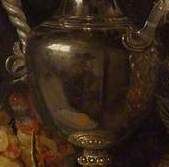

Abraham Hendricksz van Beyeren
c. 1620 - 1690
Van Beyeren was one of the greatest still life painters and certainly the most important to work in The Hague. Yet in his own lifetime, he was not famous and his paintings fetched very low prices. He probably studied under an obscure still life painter, Pieter de Putter, before becoming an independent master. Most Dutch still life painters were specialists in a specific type of work, whereas Van Beyeren did not concentrate on a single subject. He is best known for his banquet pieces but also painted fish subjects, some seascapes and a few flower pieces. He had a restless life and seems to have had little money. Many of the surviving records which mention him are court demands for payment of unpaid bills. In 1639 he lived in Leiden, returning to The Hague a year later to join the painters' guild. In 1656 he helped to found a painters' confraternity, the Confreria Pictura, in The Hague only to leave the city a year later to move to Delft where he lived until 1663. For the next six years he was back in The Hague then he moved to Amsterdam and then Alkmaar. In 1675 he moved to Gouda for two years before finally settling in Overschie near Rotterdam in 1678.
Text: CSG CIC Glasgow Museums Collection, 2025


















